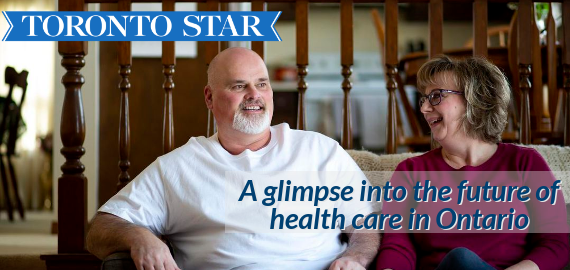Article: The Toronto Star | Reporter: Theresa Boyle | March 2, 2019
A week after having part of a cancerous lung removed, Grant Lewis grew concerned that the incision wound on his chest had become infected.
The 54-year-old Beamsville construction worker dug out a phone number he had been given when he was discharged from hospital. Call it any time, day or night, if you run into trouble, he was told.
Lewis dialed the number and was connected to his nurse, Anna Tran, at St. Joseph’s Healthcare in Hamilton. On her advice, he used his mobile phone to snap a photo of the inflamed and seeping lesion, and then emailed it to her.
Almost 40 kilometres away, Tran looked closely at the image on her cellphone. She then forwarded it to the home-care arm of St. Joe’s, along with an email requesting that Lewis be seen that same day for wound care.
Within hours of placing the call, Lewis answered a knock at his front door. It was a visiting nurse. She cleaned his wound, changed the dressing, and then updated his medical record on her tablet computer.
Tran and the rest of Lewis’ care team at St. Joe’s all had access to his electronic medical record. The home-care nurse’s update assured them all he did not have an infection and was recovering well.
This little scenario, which took place in January, provides a glimpse into the future of health care in Ontario, as Health Minister Christine Elliott envisions it.
The sectors have a reputation for being siloed. The weakest parts of the health system are the transfer points between them. Hand-offs can be bumpy and patients can fall between the cracks.
Requisitions for ongoing services don’t always get passed along in a timely fashion. Sometimes it seems like they don’t get passed along at all.
Patients, still feeling unwell, can be left to navigate their own way through the Byzantine health system, which is a world unto itself with a seemingly foreign language full of acronyms and jargon.
Because Ontario is not as far along as it could be when it comes to electronic medical records, it can take days for updates to get transmitted between providers. When care is delayed, patients’ health can deteriorate, families can panic and unnecessary trips can be made to the emergency department.
Elliott told a news conference that the overall intent of her plan is to make the system easier for patients to navigate by “seamlessly” connecting sectors and making greater use of digital tools.
Critics of the government’s plans say they are overkill and are worried that the health system could be destabilized while “radical” changes are made. That has been the experience of other provinces that have gone this route, they note. They argue that this much change is not necessary for the Conservative government to make good on election campaign commitments to end hallway medicine, open more long-term care beds and create more mental health and addiction services.
Following Elliott’s Tuesday announcement, the Star followed up with her office to get a better idea of what her reform plans would look like on the ground. It was suggested we take a look at St. Joseph’s Healthcare in Hamilton, specifically at its Integrated Comprehensive Care (ICC) program in which Lewis was a patient.
The program started as a pilot back in 2012. Known then as the “bundled care” program, it was designed to connect surgical patients with a single team of clinicians who could care for them before, during and after their operations.
To date, more than 17,000 patients have gone through St. Joe’s ICC program. In addition to thoracic surgery patients such as Lewis, they include patients who have had hip and knee replacements, suffered from chronic obstructive pulmonary disease and heart failure, undergone cardiovascular surgery and been on peritoneal dialysis.
It has resulted in a savings of up to $4,000 per patient, a 30 per cent reduction in emergency department visits and 30 per cent reduction in hospital readmissions, a savings of more than 30,000 bed days and an increase in patient satisfaction, according to the hospital.
St. Joe’s is in the process of expanding it to all surgeries and some ER patients. There are plans to further expand it to mental health and long-term care patients, and to frail seniors in their homes.
Elliott would like to see this type of program emulated across the province.
“Patients should be fully supported when returning home from the hospital and be connected to home-care services right away. A connected and co-ordinated system is our vision for a patient-centred health-care system,” she said in a written statement provided to the Star.
“The integrated-care model at St. Joseph’s Healthcare in Hamilton is a prime example of the important work that can be achieved when health care is centred around the patient,” her statement continued.
Lewis said he was very pleased with the care he received. Any concerns he had were immediately addressed and he felt confident he was in good hands, he said in a phone interview.
Best of all, he only had to stay in hospital for three nights, he noted. Assurances of good, ongoing care at home allow for quicker discharges.
“I wanted out. I am much more comfortable and relaxed in my own place,” Lewis explained
He had “virtual” followup appointments with Tran, an ICC co-ordinator and Lewis’ main point of contact in the program. Through Skype and a specially designed app, they could have face-to-face conversations, using cellphones, tablets or laptop computers.
The program has been a success with caregivers such as Lewis’ wife Nancy who said she appreciated the immediacy of it: “When you are in a hospital bed and you need help, you press a call button. That’s what this app is like. Anna Tran, someone with so much knowledge, is right there.”

